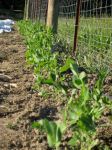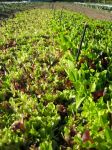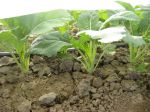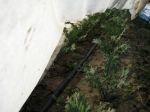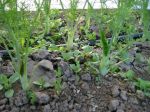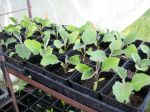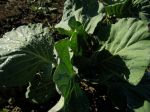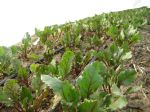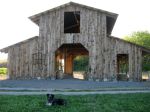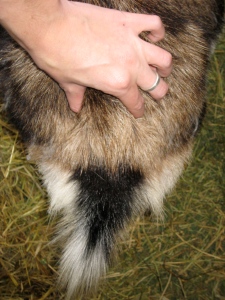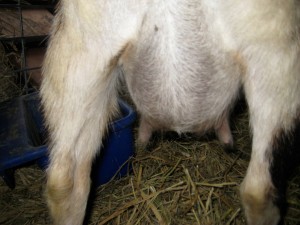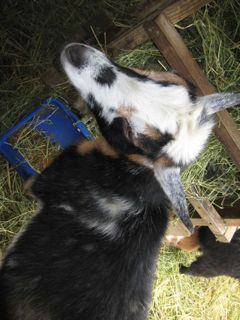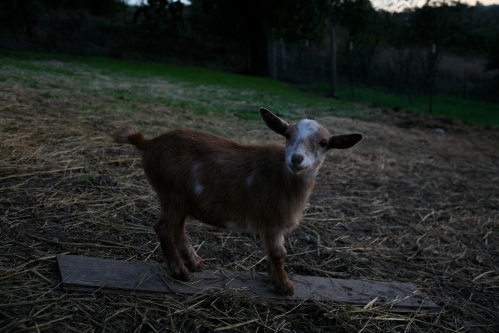
Emily watches over her new brood; everyone's tired after the difficult business of being born!
After a week’s worth of partially sleepless nights — waking at midnight, 2 a.m., and 5 a.m. to check on pregnant Emily — we pulled an all-nighter. There’s nothing like staying awake all night with a laboring goat to make you feel like a true farmer — especially if you trade off with other farmers to steal catnaps on hay bales, wrapped in a sleeping bag, shivering in a half-awake delirium and listening intently to every noise and breath sound the goat makes.
Starting at about 10 o’clock on Friday night, Emily began to show classic impending labor signs. She started pawing the ground, trying to make a nest. Amber-colored goo — amniotic fluid — began streaming out of her vagina. Emily is normally a sedate, quiet goat, but she became very affectionate and vocal, talking to us and to her stomach, and crying loudly when we left the barn. She flehmened — which is a sexual response found in sheep and goats where they curl back their lips to better smell pheromones. She sniffed the ground. She yawned. She couldn’t get comfortable, standing, lying down, and constantly readjusting herself. She chewed on her back, hoofs, and stomach, as though everything in the world was irritating her. She licked her stomach like a cat. She seemed to experience occasional mild contractions, her back arching ever so slightly and her tailhead raising.
But she still wasn’t pushing, and she wasn’t in what goat owners call “heavy labor.” Until 5:41 a.m., when quite suddenly she got serious. Inbetween contractions (which were happening every minute or two) she stood up. But when the contractions hit, she lay down, stretched out her legs, stiffened her body, and heaved. Her breathing was also really heavy, almost to the point of grunting.
I was in the kidding stall with her, bracing her legs and watching her vagina for progress–she was opening up a bit, but no sign of a bubble or kid yet. I called to Emmett, fast asleep on the hay bales. He continued to be fast asleep, no matter how loudly I said the word “Emmett.”
After a few pushes I climbed out of the kidding stall and tapped him. He was very confused by the whole situation, having been deep in dreams, but leapt out of his sleeping bag and came over to watch. I climbed back in the pen, and could see she was making progress — so I asked Emmett to get Susannah and Austin, our wwoofers who were going to assist with the birth. No sooner had they arrived (also a little groggy and confused), when a bubble appeared… first pulsing in and out with the pushes, then out to stay. Emily screamed a couple of times, the labor at its most intense. And then, just a couple of pushes after the bubble stayed out, a baby jettisoned out into my hands, butt-first.
I immediately started to pull off the mucus and clear off his face with the towel, but he wasn’t moving. He was limp, and sort of stretchy feeling. We used the aspirator — that little plastic snot-sucking bulb — to clear out his mouth (grey, lifeless tongue hanging out the side) and nostrils. I kept rubbing him vigorously, just in case, but Emmett grabbed the stethoscope and confirmed that he had no heartbeat. We continued trying to resuscitate him for a bit but it was pretty clear he was already long gone by the time he made his entrance in the world.
After so much waiting, our hearts were broken… Would there be any more kids? Was that it? I reached around Emily’s belly, about to “bounce” her to see if there were any more babies inside. But no sooner had I done so when, barely two minutes after the birth of the first one, Susannah shouted, “The next one’s coming!” Her words were somewhat of a premonition. (It wasn’t “the other one,” just the next one.)
The next one came out kicking to try and break out of the thick red sac enveloping it. We were thrilled to see signs of life, and immediately set about trying to get the baby cleaned off. We grabbed the aspirator again and cleared out the baby’s mouth and nostrils. That was literally all we had time to do before Susannah announced the birth of the next kid. We were shocked — she had three in there?! Austin took care of getting the second kid rubbed down, cleaned and dried off, and showed him to Emily so she could help with the process. (Emily, sadly, was trying her hardest to wake up the stillborn, who was on a towel on the floor of the kidding stall — so Emmett moved him away.) Then Emmett, Susannah and I set to work clearing the third baby’s lungs, and getting her cleaned off. She had a bit more mucus in her mouth than the first and was coughing and sneezing, so I gently but firmly held her by her back legs and swung her upside down to drain all of the fluid out of her longs.
At this point, I should mention why getting the kids cleaned off is so important, and so much of a challenge. The thing is, babies don’t come out like babies. They come out like a package wrapped in red plastic wrap, inside which is an ocean of water and goo, beneath which is a tiny scrawny creature that is trying desperately to breathe and doesn’t quite look ready for the world. It’s amazing that, within half an hour, these fetus-things turn into real goat babies… fluffy, trying for their first steps, and suckling with a bit of human help on mama’s teat.
Emily passed her afterbirth and immediately began chowing down on the large bloody organ-looking thing. (This seemed to be the one job more important than licking the babies — and licking babies is a job she’s been taking very seriously ever since they were born 36 hours ago.) We snipped & dipped the kids’ umbilical cords (in iodine), got them started nursing, and lifted their tails to check their genders: 1 boy and 1 girl. The boy is named “Emilio” since he is a debonair, gregarious mini-Emily. His coat patterns look just like mom. Middy, aka Midnight Oil for our long night of midwifing, is a fine-boned black doeling with a white cap and possibly a couple of moonspots. She was a bit weaker at first and took longer to find the teat on her own, but with a bit of patience (and goat Nutridrench) she’s now capering all around the kidding pen.
But that’s not the end of the story. Once we were sufficiently recovered to have the chance to look more closely at the stillborn, we realized that the stillborn kid was HUGE. Like nearly twice the size of the other kids. And overdeveloped — he had a full set of teeth, and his (ahem) “male parts” were unusually large. I remembered something very odd that Emily’s previous owner had mentioned to me; she’d taken Emily in for an ultrasound to confirm her pregnancy before selling her, and the vet had said that the fetuses weren’t the same size, so he didn’t think the fetuses were the same age. In other words, Emily had become pregnant but cycled again, and was impregnated a second time since she was in a pen with a buck. The vet also had written on the ultrasound sheet that Emily had “1+” babies inside her, which I had assumed meant that he confirmed sighting of one baby and thought that there may be others — but in retrospect I think meant that probably 1 would make it, and there may be another underdeveloped one that wouldn’t.
So while we’re sad for the big brother who never made it, we’re grateful that super-mom Emily kept all three babies in her belly until the two littler ones were ready for the world. Because right now, snuggled together under a heat lamp in the barn, are a handsome buckling who is the spitting image of his mom and a beautiful black doeling: siblings who are already the best of friends. Given Emily’s capacious udder and great mothering & birthing ability — to be able to birth a breach baby unassisted is impressive, to be able to birth an oversized lifeless breach baby in time to get the other kids out alive is pretty amazing — we’re thinking of keeping Emilio as a possible herd sire. (In other words, letting him keep his male parts intact so he can eventually make more babies.)
The stillborn is buried up under the alpaca tree, just behind the barn, where our guardian alpacas sleep and where he’ll be close to his family. Emily, Emilio, and Middy are happy as can be, snuggling and nursing, sleeping and cavorting, trying to jump up on top of mom and competing for the best teat (which is apparently the right one, much to the chagrin of Emily’s overfull left udder). And we human farmers are grateful that we can finally get a good night’s sleep — at least until April, when 3 more goats are due!
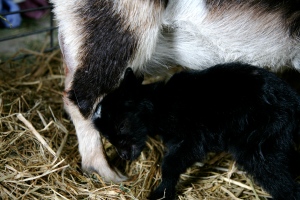
Middy, sleepy on her feet after a nursing session with Emily's coveted right teat.
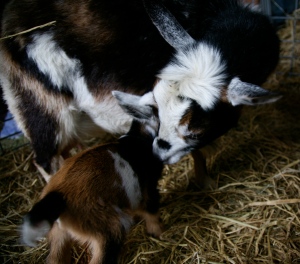
Emily smothering Emilio with goat-kisses.
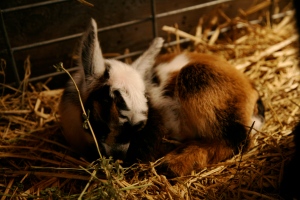
Emilio takes a brief break from his other missions in life, which are to nurse and pester his little sister. He also loves curling up in laps and peeing on people's pants.

Middy, a bit unsteady on her feet and with a milk mustache and sideburn (we were trying to make sure she got enough milk in her and maybe went a little overboard). Today, she's totally straightened out and bouncing around like the nimble goat she was born to be!



